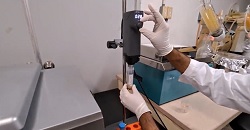Simultaneous detection and quantification of different biogenic amines
DOI:
https://doi.org/10.3329/bjp.v17i3.60650Keywords:
Biogenic amine, Histamine, derivatization, HPLCAbstract
Biogenic amines are a group of low molecular weight nitrogenous organic compounds that have an important physiological role in cell proliferation, differentiation, and signal transduction. Also, certain biogenic amines act as an important biomarker for the detection of neuroendocrine and cardiovascular disorders in humans. Besides this, the abundance of biogenic amines in food is recognized as a toxin and anti-nutritional element that have several health implications. This visual experiment demonstrates all the critical steps required for the extraction of biogenic amines followed by derivatization and high performance liquid chromatography analysis for the successive detection and quantification of biogenic amines such as histamine, cadaverine, tryptamine, agmatine, putrescine, 2-phenylethylamine, spermine, tyramine, and spermidine.
Downloads
157
126
References
Linares DM, Martín M, Ladero V, Alvarez MA, Fernández M. Biogenic amines in dairy products. Crit Rev Food Sci Nutr. 2011; 51: 691-703.
Plenis A, Olędzka I, Kowalski P, Miękus N, Bączek T. Recent trends in the quantification of biogenic amines in biofluids as biomarkers of various disorders: A review. J Clin Med. 2019; 8: 640.
Sánchez‐Jiménez F, Ruiz‐Pérez MV, Urdiales JL, Medina MA. Pharmacological potential of biogenic amine–polyamine interactions beyond neurotransmission. Br J Pharmacol. 2013; 170: 4-16.
Naila A, Flint S, Fletcher G, Bremer P, Meerdink G. Control of biogenic amines in food-existing and emerging approaches. J Food Sci. 2010; 75: 139-50.
Food and Drug Administration (US FDA). Fish and fishery products hazards and controls guidance. 4th ed. Center for Food Safety and Applied Nutrition. USA, 2011.
MFDS (The Ministry of Food and Drug Safety). Food code. Notification No. 2017-57; MFDS: Korea, 2017.
CNS (China National Standards). GB 2733-2015 National food safety standards for fresh and frozen animal aquatic products. Beijing, Standards Press of China, 2016.
Płonka J. Food analysis–samples preparation and chromatographic methods in determination of selected biogenic amines, methylxanthines and water-soluble vitamins. Anal Methods. 2012; 4: 3071-94.
Önal A. A review: Current analytical methods for the determination of biogenic amines in foods. Food Chem. 2007; 103: 1475-86.
Jubele A. Chromatographic determination of amines in food samples. 2018.
Munir MA, Badri KH. The importance of derivatizing reagent in chromatography applications for biogenic amine detection in food and beverages. J Anal Methods Chem. 2020; 2: 2020.

Downloads
Published
How to Cite
Issue
Section
License
Copyright (c) 2022 Vishal Kumar, Ashutosh Bahuguna, Myunghee Kim

This work is licensed under a Creative Commons Attribution 4.0 International License.
Authors who publish with this journal agree to the following terms:
- Authors retain copyright and grant the journal right of first publication with the work simultaneously licensed under a Creative Commons Attribution License that allows others to share the work with an acknowledgement of the work's authorship and initial publication in this journal.
- Authors are able to enter into separate, additional contractual arrangements for the non-exclusive distribution of the journal's published version of the work (e.g., post it to an institutional repository or publish it in a book), with an acknowledgement of its initial publication in this journal.
- Authors are permitted and encouraged to post their work online (e.g., in institutional repositories or on their website) prior to and during the submission process, as it can lead to productive exchanges, as well as earlier and greater citation of published work (See The Effect of Open Access).
